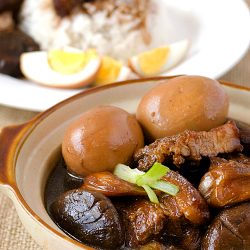Tau Yu Bak (Braised Pork Belly in Soy Sauce)
I grew up eating this homely dish of braised pork belly in soy sauce (or locally known as “tau yu bak”/豆油肉) so this is true taste of home-cooked food to me. Deliciously savoury, this dish goes very well with rice or steamed buns (kong bak bao). Every family has a different way of cooking this dish.
See Also:
- Braised Pork Belly in Root Beer Recipe
- Braised Chicken Drumsticks Recipe
- Mum’s Homely Chinese Recipes
My family’s version is no fuss – just one type of soy sauce (dark) and no need to grind the spices. The recipe is also very forgiving and flexible so you can always “rescue” it if something goes wrong. Do not overdose on the spices (like star anise, cinnamon) because a little goes a long way.
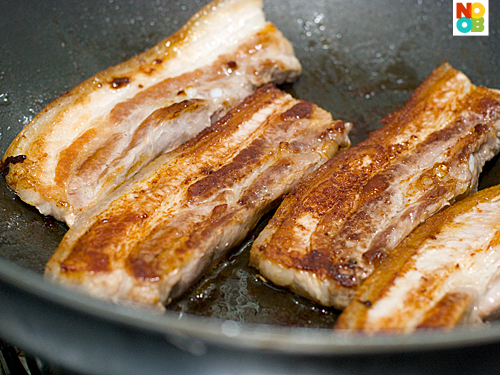
Browning the pork belly (optional but highly recommended) adds additional flavour to the stew.
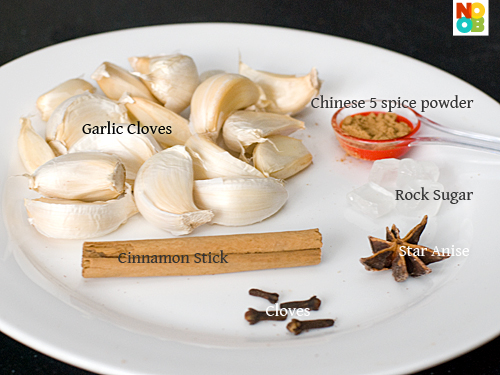
Aromatics for cooking tau yu bak – garlic, 5-spice powder, cinnamon, cloves, star anise and rock sugar.
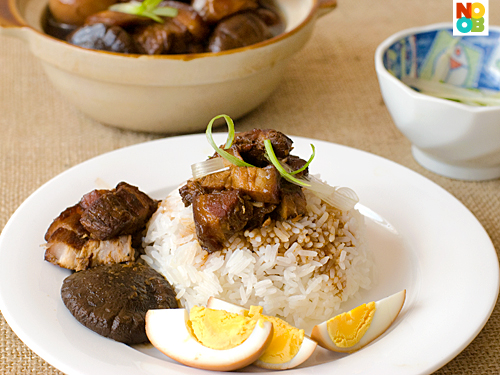
I re-created the dish from memory of the taste and I let my mum taste test the dish. Her verdict – my tau yu bak was good, and she liked that the sauce is just the right amount (if too much, the stew is diluted; too little will result in insufficient gravy for the rice & meat).
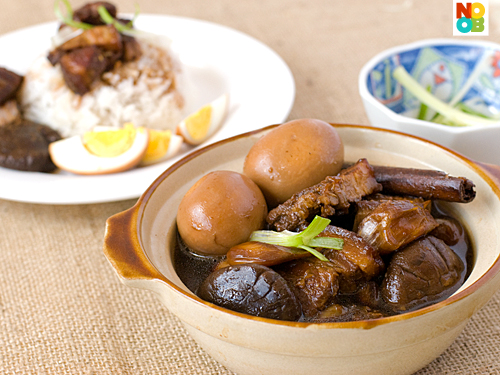
Braised Pork Belly in Soy Sauce Recipe
Constantly check that the braising sauce is not dried out during the simmering. You will need to add water (a little at a time) when the stew is drying out.
Ingredients:
- 8 dried Chinese mushrooms
- 4 eggs
- 1 tbsp cooking oil
- 500 grams pork belly
- 1.5 tbsp dark soy sauce
- 800 ml water add water (a little at a time) whenever the stew is drying out
- spring onions or coriander garnishing
- 1-2 piece of fried beancurd (tau kwa/豆干) quartered
(A) Aromatics and Seasonings
- 1.5 tbsp dark soy sauce
- 1 cinnamon stick (桂皮)
- 1 star anise (八角)
- 4 cloves (丁香)
- 1/2 tsp Chinese 5-spice powder (五香粉)
- 1.5 bulbs garlic separated into individual cloves (no need to peel)
- 1 tsp rock sugar optional; omit if you don’t like the stew sweet
- dashes of white pepper powder to taste
Directions:
- Prep mushrooms. Soak dry mushrooms in small bowl of hot water until puffy, then drain water. Squeeze out the water from mushrooms and trim away stems. Set aside the mushroom caps.
- Prepare 80% cooked hard boiled eggs. To do that, place eggs in saucepan of cold water (enough water to cover eggs one layer). Bring to a boil for about 2 minutes, turn off the stove and cover with lid for about 7 minutes (for 100% hard boiled eggs, it’s about 10 minutes). Rinse the eggs with cold water until eggs are cooled. Peel when cool enough to handle. Set aside.
- Brown the meat. Heat oil in casserole (wok, claypot or deep pot). Brown pork belly on both sides on medium heat. Add 1.5 tbsp dark soy sauce on both sides of browned pork belly.
- Make the stew. In a large stew pot, add water, aromatics (A) and mushrooms. Bring to a boil, then lower heat to a simmer (with lid partially closed) for about an hour, or until the meat is tender.
- Add protein and serve. During the last 10 minutes of simmering, add eggs and tau kwa. To serve, slice pork belly to smaller, bite-sized pieces. Serve with rice or steamed buns. Garnish with spring onions or coriander.
Cooking Notes
- Browning the meat before cooking adds depth and flavour, but you may skip this step if you are busy.
- Constantly check that the braising sauce is not dried out during the simmering. You will need to add water (a little at a time) when the stew is drying out.
- The recipe is very forgiving and flexible. Adjust to taste with dark soy sauce (for colour and sweetness), light soy sauce (for saltiness) and rock sugar for (sweetness). Simmer longer for more tender meat.
- Do not overdose on the spices (like star anise, cinnamon) as a little goes a long way.
- For best results, cook and serve this dish in a claypot. My claypot is too small for cooking, so I cooked it in a wok and transfer the cooked stew to a claypot for reheating.
Variations
If you want marbled eggs (Chinese tea leaf eggs), do not peel the eggs. Instead, gently tap the exterior of the eggs with the back of the spoon to form cracks evenly around the egg, careful to leave the entire shell still intact and covering the egg. This will create the beautiful “marbled” look and also allow the flavours to seep through the eggs.
